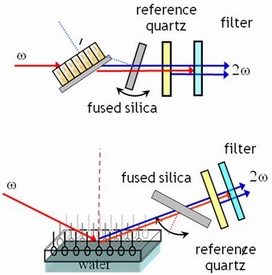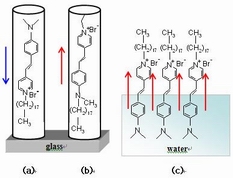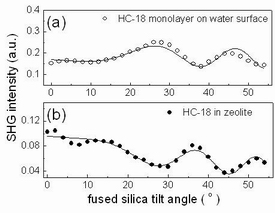Second Harmonic Phase Measurement
Second harmonic phase measurement
Second-harmonic phase measurement has been successful to determine the absolute polar orientation of adsorbed molecular dipoles by measuring the interference between the SHG signal from the sample and another source (reference) while varying the optical phase between them. It has been used mainly to compare the molecular orientation of the molecular thin films or monolayers under different conditions such as slight alteration of the adsorbing molecules, change of the substrate properties, and different deposition processes.
Hemicyanine(HC) dyes into silicalite-1 & Langmuir monolayer with against polar direction show according to change of the substrate property and the dye property
Two hemicyanine molecules with hydrophobic Hemicyanine(18-alkyl chains)dyes on opposite ends of the dipolar nonlinear optical chromophore and incorporated them into the vertical channels of a continuous silicalite-1 film grown on a glass plate and a Langmuir monolayer of the hemicyanine molecules was used as a reference sample to determine the absolute orientation of the dyes in these samples, which allows us to find out that the hydrophobic tail part of the molecule prefers to enter the silicalite-1 pore first
SHG interference fringes (in reflection mode) observed by rotating the fused quartz plate between two SHG sources. Solid line is a fit to the data. (a) HC-18 monolayer on the water surface and (b) HC-18 monolayer in zeolite.
Min et al., J. Phys. Chem. C, 111, 18159 (2007)
Kim et al., Adv. Mater.19, 260 (2007)


